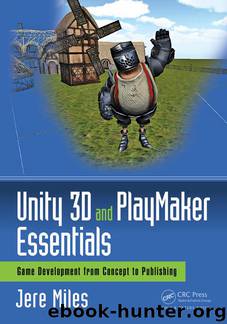Unity 3D and PlayMaker Essentials by Jere Miles

Author:Jere Miles [Miles, Jere]
Language: eng
Format: epub
Published: 0101-01-01T00:00:00+00:00
Rising
action
Falling
action
Act II
Crisis, reversal,
and climax
Act III
Conclusion
Carthasis
Act I
Beginning
Initial cause and effect
FiG 6.4 Freytag Triangle demonstrating the pattern of Aristotle’s plot.
Within the confines of the plot, Aristotle considered there to be a need for plot twists or redirections of the expected action. Aristotle presented two types of potential plot twists: change or reversal of fortune and recognition. All plots have a change or reversal of fortune, in the simplest of plots this change of fortune is when the bad guy loses in the end despite their expectation to win. Specifically a reversal of fortune occurs when the events of the plot switch such that the result of the event leads to the reverse of what the character causing the event expected to happen. A simple example would be a character pulling a trigger of an unloaded gun only to have it not shoot any bullets. If the character had been relying on the gun’s ability to fire bullets when the trigger was pulled, then the character has now suffered a reversal of fortune. More complex plots have a change of fortune and recognition, or a change from innocence. This occurs when a character goes from not knowing something to having knowledge. Depending on the knowledge that is learned, the character will either have a very positive or negative emotional response, either great love and happiness or great sorrow and despair. This knowledge discovery should go hand in hand with reversal of fortune.
Bringing this knowledge into the development of a game can be accomplished through revealing information to the player at the same time that the character finds the information. This is a challenging task to accomplish, as we will see in Sections 6.7 and 6.8 when we design and implement some of our own story elements; however, we must remember that the player is not only the audience of our story but also the lead character, the hero. As a result we need the player to experience the story as the hero, to experience the story through the eyes of the hero so that the player’s thoughts may align with those of the hero. We need the player to discover knowledge at the same time, or close to it, as the hero of the story does. The player must experience the themes of the story through the eyes and emotional construction of our hero character.
Download
This site does not store any files on its server. We only index and link to content provided by other sites. Please contact the content providers to delete copyright contents if any and email us, we'll remove relevant links or contents immediately.
Blood, Sweat, and Pixels by Jason Schreier(3580)
Godot 4 Game Development Cookbook by Jeff Johnson(2894)
Dawn of the New Everything by Jaron Lanier(2751)
The Art of Doom by Bethesda(2126)
Significant Zero by Walt Williams(1943)
Creative Character Design by Bryan Tillman(1905)
Human-Computer Interaction in Game Development with Python: Design and Develop a Game Interface Using HCI Technologies and Techniques by Joseph Thachil George Meghna Joseph George(1886)
Art Of Atari by Tim Lapetino(1768)
World of Warcraft Chronicle Volume 3 by Blizzard Entertainment(1720)
The Ultimate Roblox Book by David Jagneaux(1668)
Mission Python by Sean McManus(1667)
Pillars of Eternity Guidebook by Obsidian Entertainment(1641)
Dawn of the New Everything: Encounters with Reality and Virtual Reality by Jaron Lanier(1595)
Unreal Engine 4 Virtual Reality Projects by Kevin Mack(1537)
1628927445Game by Unknown(1535)
Unreal Engine Virtual Reality Quick Start Guide by Jessica Plowman(1531)
The Ultimate Player's Guide to Minecraft by Stephen O'Brien(1507)
Learning D by 2015(1503)
Unity 2018 By Example by Alan Thorn(1444)
